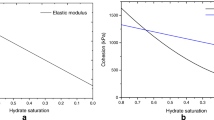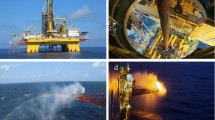Depressurized production from natural gas hydrates can lead to fluid flow, heat transfer, and geomechanical changes in the reservoir. For a submarine hydrate-bearing slope, these changes could potentially be catastrophic if they trigger large seafloor slides. To predict submarine slope instability, a numerical model has been developed for simplified thermo-hydro-mechanical coupled analysis. Within this framework, the changes in the mechanical behavior of the hydrate reservoir and changes in hydrate saturation and heat transfer can all be determined simultaneously during hydrate dissociation. Combined with finite element strength reduction analysis, the stability of submarine slopes during hydrate dissociation has been evaluated. Natural gas production may lead to slope instability with potential slip surfaces migrating to shallow levels in the slope.
Similar content being viewed by others
References
K. C. Hester, E. T. Peltzer, and P. M. Walz, “A natural hydrate dissolution experiment on complex multi-component hydrates on the sea floor,” Geochim. Cosmochim. Acta, 73, 6747-6756 (2009).
M. Sanchez, X. R. Gai, and J. C. Santamarina, “A constitutive mechanical model for gas hydrate bearing sediments incorporating inelastic mechanisms,” Comput. Geotech., 84, 28-46 (2017).
M. Maslin, N. Mikkelsen, C. Vilela, and B. Haq, “Sea level and gas hydrate controlled catastrophic sediment failures of the Amazon Fan,” Geology., 26, 1107-1110 (1998).
N. Sultan, P. Cochonat, and P. Canals, “Triggering mechanisms of slope instability processes and sediment failures on continental margins: a geotechnical approach,” Mar. Geol., 213, 291-321 (2004).
N. Sultan, P. Cochonat, J. P. Foucher, and J. Mienert, “Effect of gas hydrates melting on seafloor slope stability,” Mar. Geol., 231, 379-401 (2004).
J. Mienert, M. Vanneste, and S. Bunz, “Ocean warming and gas hydrate stability on the mid-Norwegian margin at the Storegga Slide,” Mar. Pet. Geol., 22, 233-244 (2005).
W. Y. Jung and P. R. Vogt, “Effects of bottom water warming and sea level rise on Holocene hydrate dissociation and mass wasting along the Norwegian-Barents Continental Margin,” J. Geophys. Res. Lett., 109, B06104 (2004).
M. F. Nixon and J. L. H. Grozic, “Submarine slope failure due to gas hydrate dissociation: a preliminary quantification,” Can. Geotech. J., 44, 314-325 (2007).
H. T. Zhang and X. Q. Luo, “Submarine slope stability analysis during natural gas hydrate dissociation,” Mar. Georesour. Geotechnol., 37, 467-476 (2019).
B. J. Song and Y. F. Cheng, “Seafloor subsidence response and submarine slope stability evaluation in response to hydrate dissociation,” J. Nat. Gas Sci. Eng., 65, 297-211 (2019).
G. Ahmadi and D. H. Smith, “Production of natural gas from methane hydrate by a constant down-hole pressure well,” Energy. Convers. Manage., 48, 2053-2068 (2007).
H. C. Kim, P. R. Bishnoi, and R. A. Heidemann, “Kinetics of methane hydrate decomposition,” Chem. Eng. Sci., 42, 1645-1653 (1987).
S. Kimoto, F. Oka, T. Fushita, and M. Fujiwaki, “A chemo-thermo-mechanically coupled numerical simulation of the subsurface ground deformations due to methane hydrate dissociation,” Comput. Geotech., 34, 216-228 (2007).
S. Gupta, R. Helmig, and B. Wohlmuth, “Non-isothermal, multi-phase, multi-component flows through deformable methane hydrate reservoirs,” Comput. Geosci., 19, 1063-1088 (2015).
Y. Masuda, S. Naganawa, and S. Ando, “Numerical calculation of gas production performance from reservoirs containing natural gas hydrate,” SPE Journal, 29, 201-210 (1997).
X. H. Zhang, S. Y. Wang, and Q. P. Li, “Experimental study of mechanical properties of gas hydrate deposits,” Rock. Soil. Mech., 31, 3069-3074 (2010).
X. Sun, H. Luo, and K. Soga, “A coupled thermal-hydraulic-mechanical-chemical model for methane hydrate bearing sediments using COMSOL Multiphysics,” J. Zhejiang Univ. Sci. A, 19, 600-623 (2018).
Author information
Authors and Affiliations
Corresponding author
Additional information
Translated from Osnovaniya, Fundamenty i Mekhanika Gruntov, No. 6, November-December, 2022.
Rights and permissions
Springer Nature or its licensor (e.g. a society or other partner) holds exclusive rights to this article under a publishing agreement with the author(s) or other rightsholder(s); author self-archiving of the accepted manuscript version of this article is solely governed by the terms of such publishing agreement and applicable law.
About this article
Cite this article
Li, K., Kong, L., Sun, KM. et al. Study on the Stability of Submarine Hydrate-Bearing Slope Due to Depressurized Production. Soil Mech Found Eng 59, 591–598 (2023). https://doi.org/10.1007/s11204-023-09855-6
Published:
Issue Date:
DOI: https://doi.org/10.1007/s11204-023-09855-6




